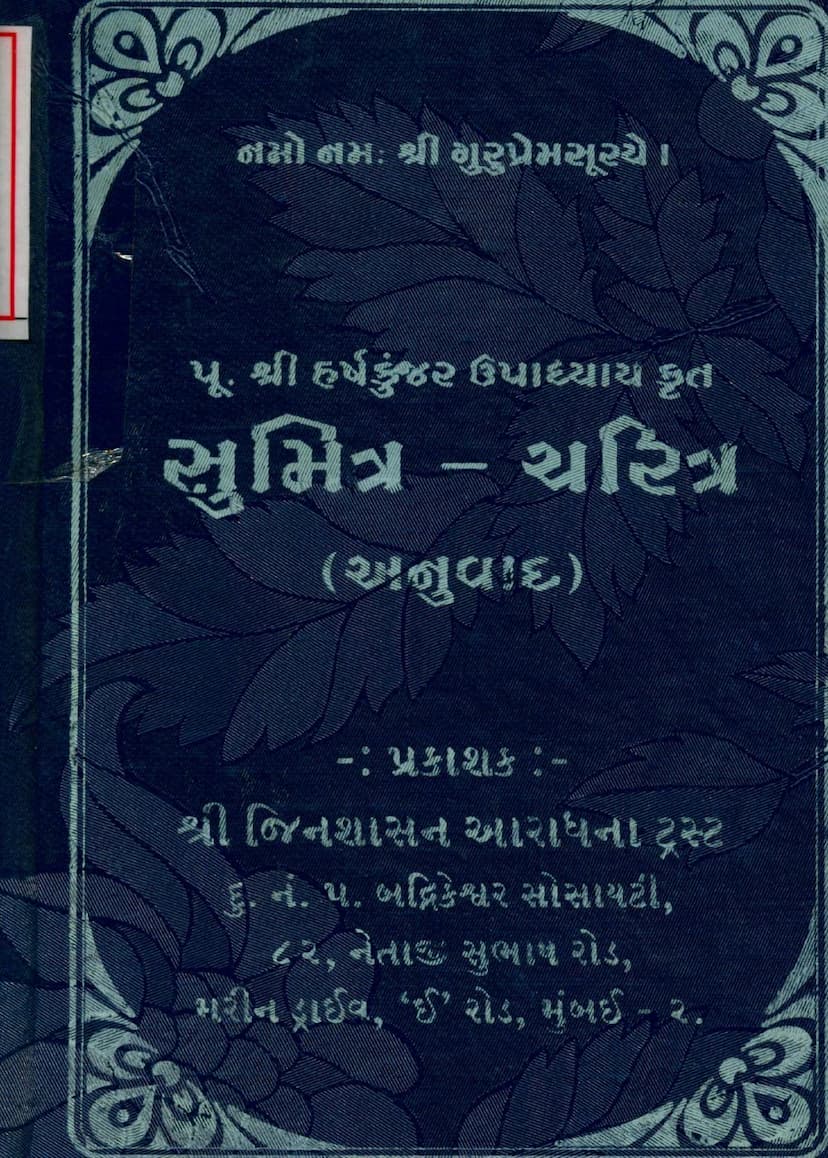Sumitra Charitra
Added to library: September 2, 2025

Summary
Here's a comprehensive summary of the Jain text "Sumitra Charitra" by Harshkunjarvijay, based on the provided pages:
Book Title: Sumitra Charitra (The Life of Sumitra) Author: Acharya Shri Harshkunjarvijay Publisher: Shri Jinshasan Aradhana Trust
Overview:
"Sumitra Charitra" is a Jain religious narrative detailing the virtuous life of Prince Sumitra, focusing on his adherence to Dharma (righteousness), his encounters with various individuals and situations, and ultimately his path to spiritual liberation. The text emphasizes the importance of good conduct, the consequences of karma, and the power of devotion to the Jain Tirthankaras.
Key Themes and Narrative Arc:
The story begins by establishing the importance of Dharma, describing it as the source of happiness, wealth, and spiritual attainment. The text then introduces the protagonist, Prince Sumitra, born into a prosperous and noble lineage in the city of Champapur. His early life is marked by his inherent virtues and his association with loyal friends, including Sur, Sidhar, Sutram, and Sagar.
The narrative follows Sumitra as he faces various challenges and learns important life lessons:
- Education and Early Virtues: Sumitra receives a comprehensive education in various arts and sciences. His inherent humility and respect for his teachers are highlighted, contrasting with the arrogance of other princes.
- Divine Protection and Forewarnings: Sumitra's mother, through a prophecy, foresees future calamities and has a protective amulet placed in Sumitra's sword hilt. This amulet later proves crucial for his protection.
- Exile and Trials: Due to misinterpretations and political machinations, Sumitra is banished from his kingdom. This marks the beginning of his worldly journey where he encounters diverse characters and situations.
- Acquiring Knowledge and Virtuous Friendships: During his travels, Sumitra and his friends seek out and learn various potent vidyas (specialized knowledge or skills) from enlightened beings.
- Sidhar learns the knowledge to see footprints, even those from six months prior.
- Sutram acquires the knowledge of reviving the dead with medicinal herbs.
- Sagar learns the art of creating flying vehicles from wood.
- Sur gains the knowledge of the inexhaustible vessel (Akshaypatra).
- Encounter with the Rakshasa and Princess Priyangu: Sumitra arrives at an abandoned city and encounters Princess Priyangu, who is held captive by a Rakshasa (demon). Sumitra heroically slays the Rakshasa and frees the princess, eventually marrying her. This event underscores his bravery and commitment to justice.
- The Deceit of the Courtesan Vairini: A skilled courtesan (Vairini), driven by past karma and a desire for revenge, orchestrates a complex plot against Sumitra and Priyangu. She manipulates events to cause distress and attempts to seize Priyangu for King Makaradhwaj.
- The Reunion with Friends and the Power of Penance: Sumitra's friends, who have acquired their respective vidyas, eventually reunite with him. They discover Sumitra in a comatose state, caused by Vairini's treachery. Through the combined efforts of his friends, particularly Sutram's revived knowledge, Sumitra is brought back to life.
- The Past Life Revelation: A divine discourse by a Kevali (omniscient being) reveals the past lives of Sumitra, Priyangu, and their friends. It is revealed that their current trials are the result of their past actions, particularly their attachment to material possessions and their lack of contentment, leading to karmic repercussions. The story highlights how even a small act of anger towards a servant in a past life resulted in the current hardships.
- Embracing Dharma and Renunciation: Deeply impacted by the teachings and the understanding of karma, King Sumitra, along with Queen Priyangu and his friends, decides to renounce worldly pleasures and embrace the path of spiritual discipline (charitra).
- Asceticism and Liberation: Sumitra and his companions live lives of severe penance and devotion, purifying their souls. They ultimately attain Kevala Jnana (omniscience) and achieve Moksha (liberation) from the cycle of birth and death.
Key Figures and Their Roles:
- Prince Sumitra: The virtuous protagonist, destined for greatness and spiritual enlightenment.
- Priyangu (Princess): Sumitra's devoted wife, who remains steadfast in her chastity and loyalty, even in the face of adversity.
- Sur, Sidhar, Sutram, Sagar: Sumitra's loyal friends, who exemplify the importance of friendship and the pursuit of knowledge.
- Vairini (Courtesan): A character driven by past karma and malice, representing the destructive consequences of negative emotions.
- Kevali Bhagwant: An enlightened spiritual guide who provides crucial teachings about karma, Dharma, and the path to liberation.
- King Dhawlvahan: Sumitra's father.
- Queen Pritimati: Sumitra's mother.
Moral and Spiritual Lessons:
"Sumitra Charitra" offers several profound moral and spiritual lessons:
- The law of Karma: The narrative strongly emphasizes that all actions have consequences, and one must face the results of their past deeds, both positive and negative.
- The Importance of Dharma: The text repeatedly highlights Dharma as the ultimate path to happiness, prosperity, and spiritual liberation.
- The Power of Contentment (Santosh): The story illustrates how dissatisfaction and greed lead to suffering, while contentment brings true happiness and spiritual progress.
- The Value of Virtuous Friendship: The unwavering loyalty and support of Sumitra's friends underscore the significance of true companionship.
- The Strength of Chastity and Devotion: Priyangu's unwavering virtue and devotion serve as an example of spiritual strength in difficult times.
- The Futility of Attachment: The text discourages excessive attachment to worldly possessions and pleasures, as they are transient and can lead to suffering.
- The Path to Liberation: The ultimate message is that through righteous conduct, spiritual discipline, and detachment, one can achieve liberation from the cycle of rebirth.
In essence, "Sumitra Charitra" is an inspiring Jain text that guides readers towards a virtuous life, emphasizing the eternal principles of Dharma and the ultimate goal of spiritual freedom.